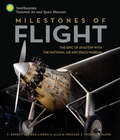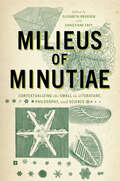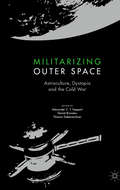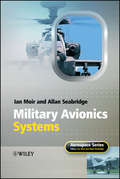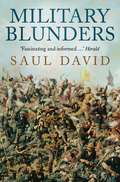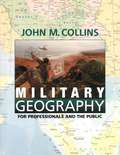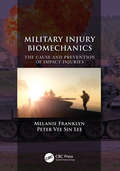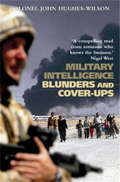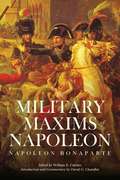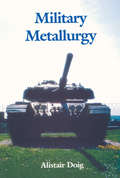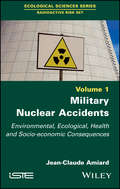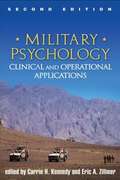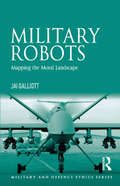- Table View
- List View
Milestones of Flight: The Epic of Aviation with the National Air and Space Museum
by F. Robert van der Linden Alex M. Spencer Thomas J. PaoneExperience the history of flight with the world-class aviation collection at the Smithsonian's National Air and Space Museum, which attracts millions and millions of visitors each year in Washington, D.C.From the moment the Wright Brothers first took flight in 1903 to the modern-day reliance on stealth aircraft and drones, there have been significant advances made in aviation. Milestones of Flight celebrates each era of advancements by showcasing the Smithsonian National Air and Space Museum's world-class aircraft collection. Authored by Dr. Robert van der Linden, a leading expert on aviation and Chairman of the Aeronautics Department at the NASM, this book is a stunning profile of the advancements in flight from decade to decade, illustrated with beautiful, large-scale photography and enhanced with little-known facts, anecdotes, and insights from major players in the aviation industry.Climb inside the cockpit of the Spirit of St. Louis that Charles Lindbergh piloted solo across the Atlantic Ocean, making history. Contrast that with a Boeing B-29 Superfortress, the first aircraft to drop an atomic bomb. The full-page photos of each milestone-making aircraft are accompanied by timelines to showcase related aircraft as well as sidebars with interesting and little-known facts, stories, and related research.Milestone categories include:- Era of Early Flight- World War I First Fighters- Long-Range Record-Setting Flight- Popular Flight- First Commercial Airliners- World War II Aircraft- Experimental Flight- Cold War Military/Korean Conflict Aircraft- Commercial Jets- Modern Military AircraftWhat will the next milestone be?
Milestones: Normal Speech and Language Development Across the Life Span
by John W. Oller Stephen D. Oller Linda C. BadonThis book provides an introduction to cutting-edge theory and research dealing not only with the development of speech forms but with the full range of sign systems that undergird normal speech and language development across the whole life span.
Milieus of Minutiae: Contextualizing the Small in Literature, Philosophy, and Science
by Cynthia Wall Hans-Jörg Rheinberger Christopher Johnson Roger Maioli Margareta Ingrid Christian Andreas Mahler Marianne Schuller Mareike Schildmann Elena Fabietti Carmen Schmechel Dan Liu Malte RauchThe long history of tiny matter(s) in the sciences, thought, and culture From catastrophic weather and steady warming caused by the accumulation of carbon particles in the Earth&’s atmosphere to societies brought to a standstill by microscopic viruses, the new millennium has reminded us of how the minutest of phenomena can have outsized effects. This notion is one that has preoccupied the European and Anglo-American cultural imaginary since at least early modernity.Milieus of Minutiae brings together an interdisciplinary group of scholars to investigate various forms and appearances of minutiae prior to and beyond the advent of magnification. The collection illuminates connections between the empirical practices and technologies with which minutiae have come to be associated and the broader, more diffuse discourses—from the philosophical to the artistic—that have attended theories of smallness before and after Hooke&’s Micrographia. Placing essays on Renaissance poetry, Romantic fiction, and matters of punctuation alongside essays on early modern germ theory and the optics of microscopic technology, this rigorously framed volume extends from sixteenth-century pathology to twentieth-century architectural theory, natural science to literature and art.
Militarizing Outer Space: Astroculture, Dystopia and the Cold War (Palgrave Studies in the History of Science and Technology)
by Alexander C. T. Geppert Daniel Brandau Tilmann SiebeneichnerMilitarizing Outer Space explores the dystopian and destructive dimensions of the Space Age and challenges conventional narratives of a bipolar Cold War rivalry. Concentrating on weapons, warfare and violence, this provocative volume examines real and imagined endeavors of arming the skies and conquering the heavens. The third and final volume in the groundbreaking European Astroculture trilogy, Militarizing Outer Space zooms in on the interplay between security, technopolitics and knowledge from the 1920s through the 1980s. Often hailed as the site of heavenly utopias and otherworldly salvation, outer space transformed from a promised sanctuary to a present threat, where the battles of the future were to be waged. Astroculture proved instrumental in fathoming forms and functions of warfare’s futures past, both on earth and in space. The allure of dominating outer space, the book shows, was neither limited to the early twenty-first century nor to current American space force rhetorics.
Militarizing the Environment: Climate Change and the Security State
by Robert P. MarzecAs the seriousness of climate change becomes more and more obvious, military institutions are responding by taking a prominent role in the governing of environmental concerns, engaging in &“climate change war games,&” and preparing for the effects of climate change—from conflicts due to loss of food, water, and energy to the mass migration of millions of people displaced by rising sea levels. This combat-oriented stance stems from a self-destructive pattern of thought that Robert P. Marzec names &“environmentality,&” an attitude that has been affecting human–environmental relations since the seventeenth century.Militarizing the Environment traces the rise of this influential mindset in America and other nations that threatens to supplant ideas of sustainability with demands for adaptation. In this extensive historical study of scientific, military, political, and economic formations across five centuries, Marzec reveals how environmentality has been instrumental in the development of today&’s security society—informing the creation of the military-industrial complex during World War II and the National Security Act that established the CIA during the Cold War.Now embedded in contemporary Western thought, environmentality has even infiltrated scientific thinking—transforming Darwinian insights into a quasi-theology that makes security the biological basis of existence. Marzec exposes the self-destructive nature of this increasingly accepted worldview and offers alternatives that counter the blind alleys of national and global security.
Military Adaptation in War
by Williamson MurrayMilitary Adaptation in War addresses one of the most persistent, yet rarely examined, problems that military organizations confront: namely, the problem of how to adapt under the trying, terrifying conditions of war. This work builds on the volume that Professor Williamson Murray edited with Allan Millett on military innovation (a quite different problem, though similar in some respects). In Clausewitzian terms, war is a contest, an interactive duel, which is of indeterminate length and presents a series of intractable problems at every level, from policy and strategy down to the tactical. Moreover, the fact that the enemy is adapting at the same time presents military organizations with an ever-changing set of conundrums that offer up no easy solutions. As the British general, James Wolfe, suggested before Quebec: "War is an option of difficulties. " Dr. Murray provides an in-depth analysis of the problems that military forces confront in adapting to these difficulties.
Military Avionics Systems (Aerospace Series #6)
by Ian Moir Allan SeabridgeThis book introduces the military roles expected of aircraft types and describes the avionics systems required to fulfill these roles. These range from technology and architectures through to navigations systems, sensors, computing architectures, and the human-machine interface. It enables students to put together combinations of systems in order to perform specific military roles. <P><P>A complementary volume to the authors’ previous title Civil Avionics Systems, this book covers a wide range of military aircraft roles and systems applications. It offers clear and concise system descriptions; includes case studies and examples from real life, current projects; and features numerous illustrations and photographs. <P><P> It is a valuable resource for students of aerospace engineering as well as practitioners in the field of aerospace who wish to extend their knowledge.
Military Blunders: The How And Why Of Military Failure
by Saul DavidRetelling the most spectacular cock-ups in military history, this graphic account has a great deal to say about the psychology of military incompetence and the reasons even the most well-oiled military machines inflict disaster upon themselves. Beginning in AD9 with the massacre of Varus and his legions in the Black Forest all the way up to present day conflict in Afghanistan it analyses why things go wrong on the battlefield and who is to blame.
Military Blunders: The How And Why Of Military Failure
by Saul DavidRetelling the most spectacular cock-ups in military history, this graphic account has a great deal to say about the psychology of military incompetence and the reasons even the most well-oiled military machines inflict disaster upon themselves. Beginning in AD9 with the massacre of Varus and his legions in the Black Forest all the way up to present day conflict in Afghanistan it analyses why things go wrong on the battlefield and who is to blame.
Military Capabilities for Hybrid War: Insights from the Israel Defense Forces in Lebanon and Gaza
by David E. JohnsonThe Israel Defense Forces have gained much experience against hybrid opponents--Hezbollah and Hamas--in recent conflicts in Lebanon and Gaza. The lessons from these experiences are relevant to understanding the capabilities the U.S. Army and the joint force will require in the future. Principal findings highlight the importance of combined arms fire and maneuver; precision, standoff fires; responsive air and artillery support; and heavy forces.
Military Enlistment of Hispanic Youth: Obstacles and Opportunities
by Beth J. Asch Jacob Alex Klerman David S. Loughran Meredith Kleykamp Christopher BuckAlthough polls of Hispanic youth show a strong propensity to serve in the military, Hispanics are nonetheless underrepresented among military recruits. The authors discuss the major characteristics that disproportionately disqualify Hispanic youth and explore actions that could be taken to increase Hispanic enlistments.
Military Geography: For Professionals and The Public
by John M. CollinsThis book covers many topics that are crucial to military planning but often receive only passing mention in histories or briefings. Collins, a former Army officer, stresses land geography, but he does not stint oceans, the atmosphere, or interplanetary space. His discussions of urban areas are too brief, given the increasing amount of large-scale violence in cities since the end of World War II.
Military Industry and Regional Defense Policy: India, Iraq and Israel (Cass Military Studies)
by Timothy D. HoytMilitary Industry and Regional Defense Policy re-examines military industrialization in the developing world, focusing on policy-making in producer states and the impact of security perceptions on such policy-making. Timothy D. Hoyt reassesses the role of regional state sub-systems in international relations, and recent historical studies of international technology and arms transfers. Looking at Israel, Iraq and India, the three most powerful regional powers in the Cold War era, he presesnts an expert analysis of the three-sided phenomena of the regional hegemony, the regional competitor and the small over-achiever. This new book breaks away from existing literature on military industries in the developing world, which has focused on their economic and development costs and benefits. These past studies have used primitive methodologies that focus on the production of complete weapons systems - a misleading gauge in a world of growing international defense cooperation. They have also ignored empirical evidence of the impact of local military industrial production on Cold War regional conflict, and of the defence planning and concerns that drove development of indigenous military industries in key regional powers. This new text delivers an incisive new perspective.
Military Injury Biomechanics: The Cause and Prevention of Impact Injuries
by Melanie Franklyn Peter Vee LeeMilitary Injury Biomechanics: The Cause and Prevention of Impact Injuries is a reference manual where information and data from a large number of sources, focussing on injuries related to military events, has been critically reviewed and discussed. The book covers the cause and prevention of impact injuries to all the major body regions, while topics such as the historical background of military impact biomechanics, the history and use of anthropomorphic test devices for military applications and the medical management of injuries are also discussed. An international team of experts have been brought together to examine and review the topics. The book is intended for researchers, postgraduate students and others working or studying defence and impact injuries.
Military Innovation in The Interwar Period
by Williamson Murray Allan R. MillettIn 1914, the armies and navies that faced each other were alike right down to the strengths of their companies and battalions and the designs of their battleships and cruisers. Differences were of degree rather than essence. During the interwar period, however, the armed forces grew increasingly asymmetrical, developing different approaches to the same problems. This 1996 study of major military innovations in the 1920s and 1930s explores differences in exploitation by the seven major military powers. The comparative essays investigate how and why innovation occurred or did not occur, and explain much of the strategic and operative performance of the Axis and Allies in World War II. The essays focus on several instances of how military services developed new technology and weapons and incorporated them into their doctrine, organisation and styles of operations.
Military Intelligence Blunders and Cover-Ups: New Revised Edition
by Colonel John Hughes-WilsonThis book is a professional military-intelligence officer's and a controversial insider's view of some of the greatest intelligence blunders of recent history. It includes the serious developments in government misuse of intelligence in the recent war with Iraq. Colonel John Hughes-Wilson analyses not just the events that conspire to cause disaster, but why crucial intelligence is so often ignored, misunderstood or spun by politicians and seasoned generals alike. This book analyses: how Hitler's intelligence staff misled him in a bid to outfox their Nazi Party rivals; the bureaucratic bungling behind Pearl Harbor; how in-fighting within American intelligence ensured they were taken off guard by the Viet Cong's 1968 Tet Offensive; how over confidence, political interference and deception facilitated Egypt and Syria's 1973 surprise attack on Israel; why a handful of marines and a London taxicab were all Britain had to defend the Falklands; the mistaken intelligence that allowed Saddam Hussein to remain in power until the second Iraq War of 2003; the truth behind the US failure to run a terrorist warning system before the 9/11 WTC bombing; and how governments are increasingly pressurising intelligence agencies to 'spin' the party-political line.
Military Intelligence Blunders and Cover-Ups: New Revised Edition
by John Hughes-WilsonThis book is a professional military-intelligence officer's and a controversial insider's view of some of the greatest intelligence blunders of recent history. It includes the serious developments in government misuse of intelligence in the recent war with Iraq. Colonel John Hughes-Wilson analyses not just the events that conspire to cause disaster, but why crucial intelligence is so often ignored, misunderstood or spun by politicians and seasoned generals alike. This book analyses: how Hitler's intelligence staff misled him in a bid to outfox their Nazi Party rivals; the bureaucratic bungling behind Pearl Harbor; how in-fighting within American intelligence ensured they were taken off guard by the Viet Cong's 1968 Tet Offensive; how over confidence, political interference and deception facilitated Egypt and Syria's 1973 surprise attack on Israel; why a handful of marines and a London taxicab were all Britain had to defend the Falklands; the mistaken intelligence that allowed Saddam Hussein to remain in power until the second Iraq War of 2003; the truth behind the US failure to run a terrorist warning system before the 9/11 WTC bombing; and how governments are increasingly pressurising intelligence agencies to 'spin' the party-political line.
Military Maxims of Napoleon
by Napoleon Bonaparte David G. Chandler Daniel Chandler William E. CairnesAn essential volume of Napoleon’s wisdom on the art of war. Nearly two hundred years after his death, Napoleon remains widely regarded as one of the greatest military commanders of all time. Here, in one volume, is the essence of Napoleon’s knowledge and wisdom, the fruit of his practical experience, and his study of the great empire-builders from Alexander to Frederick the Great. Working from the best among previous editions of Napoleon’s maxims, including the work produced in 1901 by William E. Cairnes, noted Napoleonic historian David G. Chandler has contributed commentary that examines Napoleon’s work from the twentieth-century perspective of the two world wars, Vietnam, and other conflicts, and analyzes the ways in which commanders have observed or failed to observe Napoleon’s teachings. The Military Maxims of Napoleon is a unique collection of tenets on the art of war. They reveal the principles on which his military, diplomatic, and political triumphs were built. Now every military student and enthusiast can benefit from the brilliance of Napoleonic insight and wisdom. "The Military Maxims of Napoleon provides a most valuable insight into the Napoleonic art of war . . . David G. Chandler is the foremost modern authority on the subject, which makes this work essential reading. ” --Philip J. Haythornthwaite, author of Invincible Generals Skyhorse Publishing, as well as our Arcade imprint, are proud to publish a broad range of books for readers interested in history--books about World War II, the Third Reich, Hitler and his henchmen, the JFK assassination, conspiracies, the American Civil War, the American Revolution, gladiators, Vikings, ancient Rome, medieval times, the old West, and much more. While not every title we publish becomes a New York Times bestseller or a national bestseller, we are committed to books on subjects that are sometimes overlooked and to authors whose work might not otherwise find a home.
Military Metallurgy
by Alistair DoigThis book gives a broad based view of metals in military service, covering several examples and rationales. It is useful for the militarist and for the metallurgist or materials scientist. The content of the book is based on course notes compiled for undergraduate and post-graduate students.
Military Nuclear Accidents: Environmental, Ecological, Health and Socio-economic Consequences
by Jean-Claude AmiardThe use of atomic energy for military purposes has given rise to a variety of nuclear accidents from the outset. This applies to all levels of use: from the manufacture of weapons to their commissioning. This book provides an overview of the potential impact of such accidents. The prospective consequences of local and global nuclear war are detailed. Similarly, for each accident, the environmental, ecological, health and socio-economic consequences are reviewed. The contamination of the environment and its fauna and flora is detailed and the effects of ionizing radiation are reported. The same is provided for human populations and the adverse effects on the health and physical and mental states of the populations concerned. The economic cost of accidents is also evaluated. The research presented in this book is based on scientifically recognized publications, and reports from the military forces of the various countries concerned and from the national and international organizations competent in this field (IAEA, WHO, UNSCEAR, IRSN, ICPR, etc.).
Military Operations in Response to Domestic Emergencies and Global Pandemics: Implications for Civil-Military Relations (The Military and Society)
by Christian Leuprecht Lindy HeineckenThis open access book provides a comparative analysis of the deployment of the military in domestic operations, the use of the armed forces during the COVID-19 pandemic, and the impact of that deployment on civil-military relations in 26 countries worldwide. The book examines the legal and constitutional regulations under which the military can serve in domestic roles, and the extent of domestic deployment before the COVID-19 pandemic. It focuses on the roles in which the military served during the pandemic, the resources available, and the readiness and effectiveness of the military response. The volume addresses whether or not the pandemic response was securitized, the extent of civilian oversight and control, the accountability measures in place, and the impact of the COVID-19 deployment on the military&’s image. The volume captures the lessons learnt from the COVID-19 deployment and the implications for future force design, structure, and organizational transformation. Since almost all countries used their military in some capacity to respond to the COVID-19 pandemic, this volume offers an opportunity to compare use of the armed forces to provide domestic humanitarian assistance and disaster response.
Military Psychology, Second Edition
by Eric A. Zillmer Carrie KennedyWidely regarded as the authoritative reference in the field, this book comprehensively explores the psychological needs of today's service members and how to meet them effectively. Expert contributors review best practices for conducting fitness-for-duty evaluations and other types of assessments, treating frequently encountered clinical problems, responding to disasters, and promoting the health and well-being of all personnel. The book also examines the role of mental health professionals in enhancing operational readiness, with chapters on crisis and hostage negotiation, understanding terrorists, and more. New to This Edition The latest scientific knowledge, clinical interventions, and training recommendations. Chapter on acute combat stress. Chapter on post-deployment problems, including PTSD and depression. Chapter on military psychology ethics. Coverage of blast concussion screening and evaluation.
Military Pyrotechnics: Principles and Practices
by Ajoy K. BoseThis book covers military pyrotechnics characteristics, sensitivity, combustion, performance parameters, ingredients and their behaviour, various pyrotechnic compositions and their manufacturing methods, filling, pressing and assembly of ammunition and so forth. Divided into two broader sections, namely military pyrotechnic compositions and military pyrotechnic ammunitions and devices, it provides full spectrum of military pyrotechnics and a guide for all personnel involved with management of military pyrotechnic ammunitions and devices in design, production, inspection, training, and use. Features: *Answers "know what", "know why "and "know how" of pyrotechnic compositions and pyrotechnic ammunitions and devices * Explains various concepts and mechanisms of the military pyrotechnics *Deliberates on role and characteristics of pyrotechnic compositions and its classification *Discusses various factors affecting performance and some differences in military pyrotechnics * Describes various methods of initiation of ignition in ammunition *Elucidates basic requirements of pyrotechnic ammunitions, its development and life cycle of ammunition lots * Provides classification, division, shelf life, compatibility and nomenclature of ammunitions and devices *Reviews test/proof requirements of ammunitions and devices, deployment and functioning, defect classification, sampling plan and acceptance criteria *Explores latest trends in 'green pyrotechnics' for environment- friendly military pyrotechnics
Military Robots: Mapping the Moral Landscape (Military and Defence Ethics)
by Jai GalliottPhilosophers have wrestled over the morality and ethics of war for nearly as long as human beings have been waging it. The death and destruction that unmanned warfare entails magnifies the moral and ethical challenges we face in conventional warfare and everyday society. Intrinsically linked are questions and perennial problems concerning what justifies the initial resort to war, who may be legitimately targeted in warfare, who should be permitted to serve the military, the collateral effects of military weaponry and the methods of determining and dealing with violations of the laws of war. This book provides a comprehensive and unifying analysis of the moral, political and social questions concerning the rise of drone warfare.
Military, Naval and Civil Airships Since 1783: The History and Development of the Dirigible Airship in Peace and War
by Daniel G. Ridley-KittsExploring the history and development of the dirigible airship from its humble beginnings in the late eighteenth century, through to its current role as military command posts among other uses, this book is a comprehensive account of the dirigible airship.Starting out as an unreliable experimental aircraft as aeronauts first began to learn the secrets of aerial navigation, the airship was then remodelled in 1900 by Count Zeppelin to become a potent weapon of war then transformed again into a short-lived solution to long-distance passenger air travel. With over 100 technical drawings and contemporary images of dirigible aircraft, Ridley-Kitts here presents a comprehensive and fascinating history of the airship – a must read for those that wish the delve into the development of the aircraft for the first time and for airship specialists alike.
